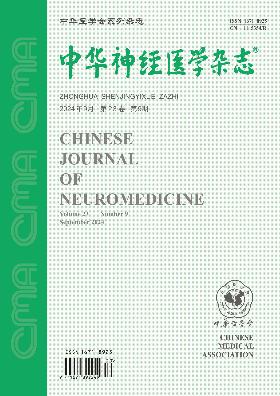Coptisine上调miR-146a-5p表达,通过PI3K/AKT通路减轻1-甲基-4-苯基啶诱导的帕金森病细胞模型损伤
Q4 Medicine
引用次数: 0
摘要
目的探讨黄柏碱对1-甲基-4-苯基啶(MPP+)诱导的帕金森病(PD)细胞损伤的影响及其机制。方法以0.3 mmol/L MPP+作用SK-N-SH细胞诱导PD细胞模型(MPP+组);正常培养细胞作为空白对照(nc);在给予0.3 mmol/L MPP+后,分别以10、20、40 μmol/L浓度的黄柏碱预处理4 h,命名不同浓度黄柏碱处理组。将miR-con和miR-146a-5p转染SK-N-SH细胞,用0.3 mmol/L MPP+处理,命名为MPP++miR-con组和MPP++miR-146a-5p组;将anti-miR-con和anti-miR-146a-5p分别转染SK-N-SH细胞,用20 μmol/L黄浦碱预处理4 h,再用0.3 mmol/L MPP+处理,命名为MPP++Cop+anti-miR-con组和MPP++Cop+anti-miR-146a-5p组。MTT法测定细胞活力;Western blotting检测裂解型含天冬氨酸半胱氨酸特异性蛋白酶-3 (caspase-3)、CyclinD1、磷酸化蛋白激酶B (p-AKT)、对磷酸肌肽3激酶(p-PI3K)的蛋白表达;流式细胞术检测细胞凋亡;采用实时定量PCR (RT-qPCR)检测miR-146a-5p的表达。结果与nc相比,MPP+诱导的SK-N-SH细胞活力、CyclinD1、miR-146a-5p表达显著降低,cleaved caspase-3表达和凋亡率显著升高(P<0.05)。经coptisine处理和miR-146a-5p过表达后,MPP+诱导的SK-N-SH细胞活力和CyclinD1、miR-146a-5p表达显著升高,cleaved-caspase-3表达和凋亡率显著降低(P<0.05)。miR-146a-5p的低表达逆转了黄浦碱对SK-N-SH细胞增殖促进和凋亡抑制的作用。coptisine处理后,MPP+诱导的SK-N-SH细胞中p-AKT和p-PI3K的表达水平显著升高。miR-146a-5p的低表达逆转了coptisine对p-AKT和p-PI3K表达的影响。结论黄柏碱可促进细胞存活,抑制MPP+诱导的细胞凋亡,其作用机制可能与miR-146a-5p和PI3K/AKT信号通路有关。关键词:科普;mir - 146 - 5 - p;PI3K/AKT信号通路;帕金森病;细胞损伤本文章由计算机程序翻译,如有差异,请以英文原文为准。
Coptisine up-regulates miR-146a-5p expression to attenuate injury of Parkinson's disease cell models induced by 1-methyl-4-phenylpy ridinium via PI3K/AKT pathway
Objective
To investigate the effect of coptisine on 1-methyl-4-phenylpy ridinium(MPP+) induced Parkinson's disease (PD) cell injury and its mechanism.
Methods
SK-N-SH cells were treated with 0.3 mmol/L MPP+ to induce PD cell models (MPP+ group); normal cultured cells were used as blank controls (NCs); pretreatment with coptisine at concentrations of 10, 20, and 40 μmol/L for 4 h was performed after giving 0.3 mmol/L MPP+, different concentration coptisine treatment groups were named. And miR-con and miR-146a-5p were transfected into SK-N-SH cells and treated with 0.3 mmol/L MPP+, and named MPP++miR-con group and MPP++miR-146a-5p group; anti-miR-con and anti-miR-146a-5p were transfected into SK-N-SH cells and pretreated with 20 μmol/L coptisine for 4 h, and then, treated with 0.3 mmol/L MPP+, and named MPP++Cop+anti-miR-con group and MPP++Cop+anti-miR-146a-5p group. Cell viability was determined by MTT assay; Western blotting was used to detect the protein expressions of cleaved cysteine-containing aspartate-specific proteases-3 (caspase-3), CyclinD1, phosphorylated protein kinase B (p-AKT), p-phosphoinositide 3 kinase (p-PI3K); apoptosis was detected by flow cytometry; real-time quantitative PCR (RT-qPCR) was used to detect the miR-146a-5p expression.
Results
As compared with the NCs, the MPP+ induced SK-N-SH cells had significantly decreased viability and CyclinD1 and miR-146a-5p expressions, and significantly increased cleaved caspase-3 expression and apoptosis rate (P<0.05). After coptisine treatment and miR-146a-5p overexpression, MPP+ induced SK-N-SH cells had significantly increased viability and expressions of CyclinD1 and miR-146a-5p, and significantly decreased cleaved-caspase-3 expression and apoptosis rate (P<0.05). Low expression of miR-146a-5p reversed the effect of coptisine on proliferation promotion and apoptosis inhibition of SK-N-SH cells. The expression levels of p-AKT and p-PI3K in MPP+-induced SK-N-SH cells were significantly increased after coptisine treatment. Low expression of miR-146a-5p reversed the effect of coptisine on expressions of p-AKT and p-PI3K.
Conclusion
Coptisine can promote cell survival and inhibit MPP+-induced apoptosis, which may be related to miR-146a-5p and PI3K/AKT signaling pathways.
Key words:
Coptisine; MiR-146a-5p; PI3K/AKT signaling pathway; Parkinson's disease; Cell injury
求助全文
通过发布文献求助,成功后即可免费获取论文全文。
去求助
来源期刊

中华神经医学杂志
Psychology-Neuropsychology and Physiological Psychology
CiteScore
0.30
自引率
0.00%
发文量
6272
期刊介绍:
 求助内容:
求助内容: 应助结果提醒方式:
应助结果提醒方式:


